Experiencing nausea and vomiting during pregnancy can be quite challenging. Simple changes, like the clothes you wear, can provide much-needed comfort during this time. In this guide, we'll explore some practical tips and tricks to help you dress comfortably throughout your pregnancy, especially when you're dealing with morning sickness.
Understanding the types of fabrics that can ease discomfort, the best styles to wear, and a few handy accessories can make all the difference. By the end of this article, you'll be well-equipped to tackle the day with a bit more comfort and confidence.
- Understanding Pregnancy Nausea and Vomiting
- Choosing Comfortable Fabrics
- Optimal Clothing Styles
- Accessory Tips for Comfort
Understanding Pregnancy Nausea and Vomiting
Nausea and vomiting during pregnancy, commonly known as morning sickness, affects a significant number of expectant mothers. Despite its misleading name, this discomfort doesn't only occur in the morning. It can strike at any point during the day or night. This condition usually starts around the sixth week of pregnancy and tends to subside by the end of the first trimester. However, some women may experience it throughout their entire pregnancy.
Morning sickness is often attributed to the rapid hormonal changes your body undergoes when you become pregnant. These hormonal shifts, particularly in levels of human chorionic gonadotropin (hCG) and estrogen, are believed to affect your digestive system and sense of smell, leading to nausea and vomiting. While these symptoms are generally harmless, they can be very uncomfortable and can interfere with your daily life significantly.
According to the American Pregnancy Association, around 70-80% of pregnant women experience some form of morning sickness. While the cause isn't entirely understood, several factors like stress, fatigue, and carrying multiple babies can make it worse. To manage these symptoms, many women find it helpful to eat smaller, more frequent meals and avoid triggers like strong smells and spicy foods.
“Many women find relief through dietary modifications and stress reduction techniques. However, each pregnancy is unique, and what works for one woman may not work for another,” says Dr. Anne Smith, an obstetrician.
Interestingly, some studies suggest that mothers who experience nausea and vomiting may have lower risks of miscarriage, possibly due to higher levels of certain pregnancy hormones thought to benefit the developing baby. Still, the day-to-day experience can be quite taxing, and finding ways to stay comfortable is essential.
Understanding the underlying causes of these symptoms and recognizing that it's a common experience can be helpful in managing it. While there is no one-size-fits-all solution, many women benefit from a combination of dietary changes, physical comfort strategies, and sometimes medication, prescribed by a healthcare provider, to ease these symptoms. In the next sections, we'll explore specific tips and clothing choices that can make a big difference in how you feel during this challenging time.
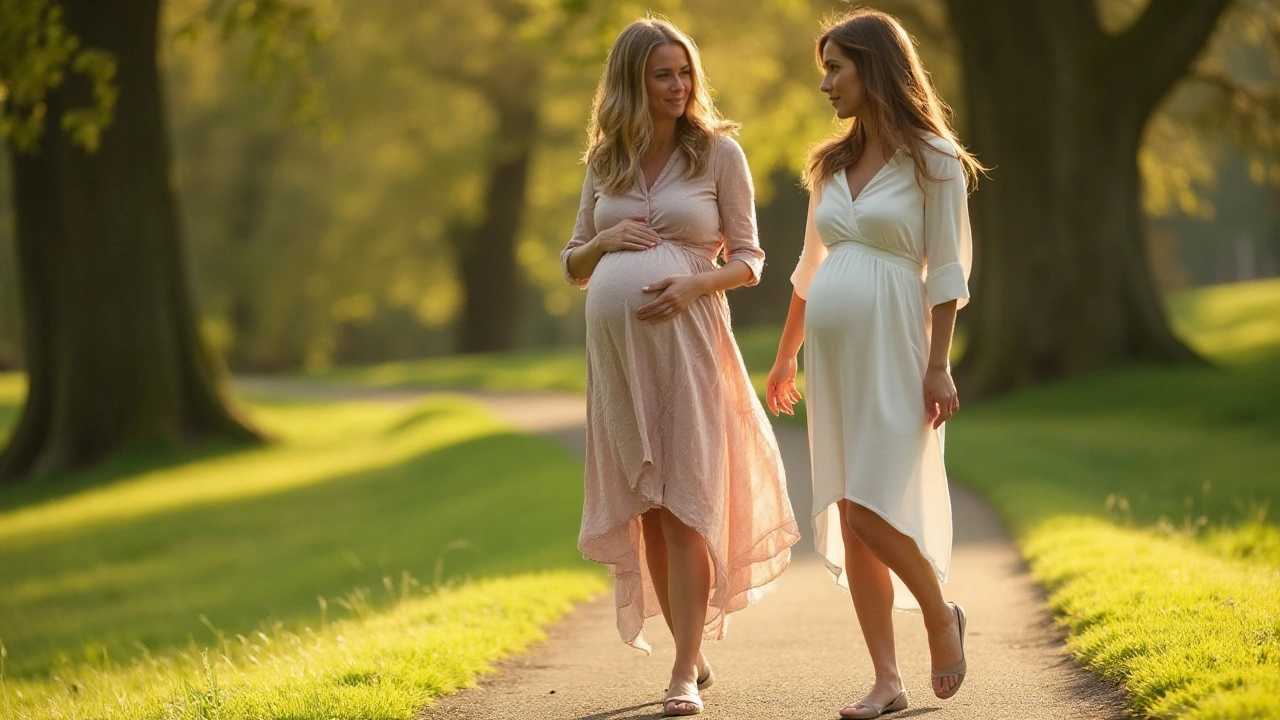
Choosing Comfortable Fabrics
When you're experiencing pregnancy vomiting, the fabric you choose for your clothing can make a significant difference in your comfort level. The right fabrics are breathable and soft against the skin, reducing irritation and making it easier to tolerate the symptoms of nausea. One excellent option is cotton. It's a natural fabric that breathes well and is soft to the touch. Cotton also absorbs moisture, which can be particularly helpful if you're prone to sweating during bouts of nausea.
Bamboo fabric is another great option. It's incredibly soft, more so than cotton, and boasts natural antibacterial properties. This fabric is also highly breathable and has moisture-wicking abilities, meaning it draws moisture away from the skin and keeps you feeling dry. Many women find bamboo fabric to be incredibly comfortable, especially during the uncomfortable stages of pregnancy.
Jersey knit is a fabric worth considering as well. This blend is usually made from cotton or synthetic fibers. The great thing about jersey knit is its stretchiness, allowing for a comfortable fit that moves with your body. As your body changes during pregnancy, fabrics like jersey knit become invaluable due to their flexibility and softness.
Silk might not be the first fabric you reach for due to its delicate nature, but it is exceptionally smooth and gentle on sensitive skin. Although silk requires a bit of extra care, its hypoallergenic properties make it an excellent option for those with sensitive skin. Just ensure you're wearing loose-fitting silk clothing to maximize comfort.
Another fabric to highlight is modal, a type of rayon made from beech tree pulp. It's not only incredibly soft but also breathable and resistant to shrinkage. Many maternity brands use modal in their clothing lines because it provides comfort while maintaining its shape and texture after many washes. Modal also has moisture-wicking properties, making it another excellent choice during pregnancy vomiting episodes.
Linen deserves a mention too. Although it can wrinkle easily, it's extremely breathable and light. Linen allows air to flow freely, which can help you stay cool and comfortable. If you find other fabrics too heavy or warm, linen might be the perfect alternative for those hot or uncomfortable days.
When choosing fabrics, it's also helpful to consider blends. Sometimes, a combination of cotton and spandex or bamboo and spandex can provide the best of both worlds: breathability, softness, and flexibility. Look for these blends in clothing labeled specifically for maternity wear, as they're designed with your changing body in mind.
Dr. Anne Matthews, a maternity clothing specialist, often advises her patients: "The key is to avoid synthetic fabrics like polyester, which can trap heat and moisture, exacerbating your discomfort during nausea episodes. Stick to natural fibers whenever possible."
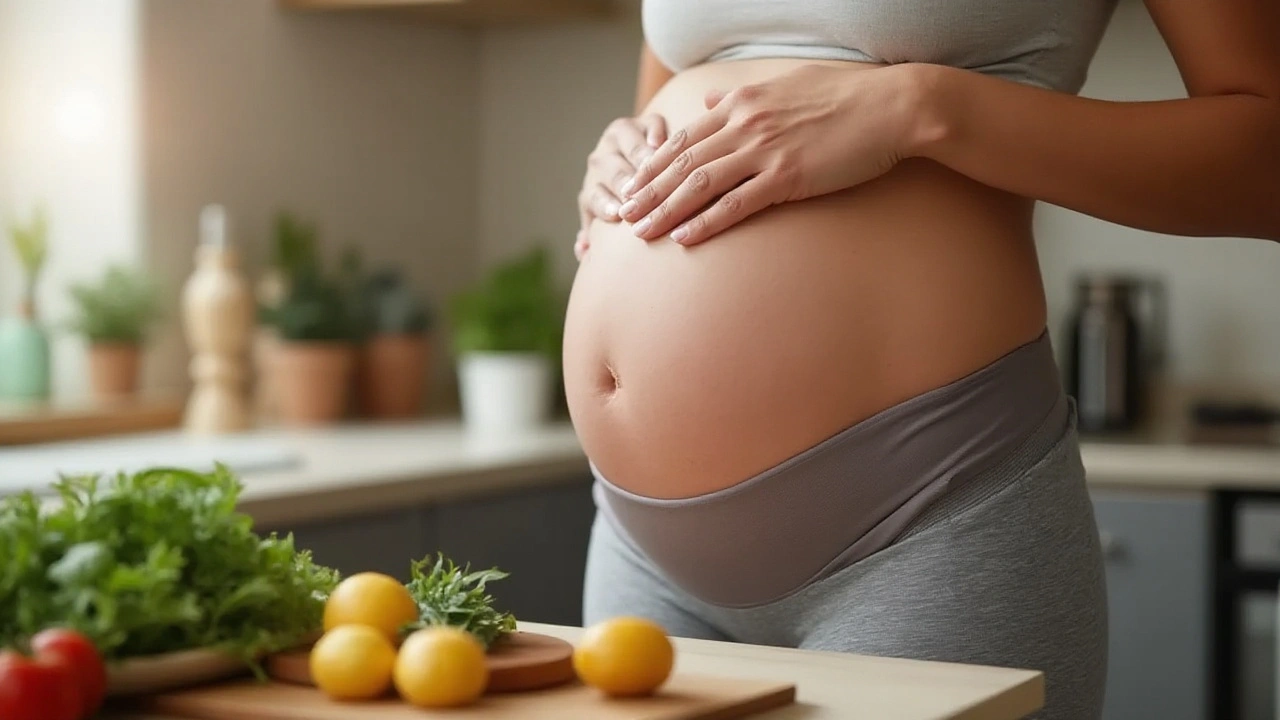
Optimal Clothing Styles
When you're experiencing pregnancy vomiting and nausea, the right clothing style can vastly improve your comfort. It’s not just about looking good – the right clothes can help you feel much better, too. Loose-fitting garments are among the best choices. Dresses that flow freely, especially those made from soft fabrics like cotton or bamboo, can be both elegant and cozy. Avoid tight waistbands or anything that constricts your belly area, as pressure can intensify nausea symptoms.
Opt for clothes that are easy to put on and take off. Wrap dresses, for example, not only offer the flexibility of adjustment as your body changes but are also a breeze to manage on rough days. Tops and bottoms with elastic waistbands or adjustable ties are also good options. These allow for changes in size without creating discomfort. Look for pants labeled as maternity wear, as they are specifically designed to provide a comfortable fit as your belly grows.
Maternity leggings and yoga pants provide support while still being gentle on the stomach. Paired with a loose-fitting top, they can make an ideal outfit for lounging at home or even casual outings. Pregnant women who prefer skirts might find maternity skirts with supportive waistbands very helpful. These skirts give a bit of compression and hold without squeezing, making them a popular choice.
Layering can offer additional comfort. Layers allow you to easily adapt to temperature changes, which can be very helpful if you’re prone to hot flashes or sudden chills, often experienced during pregnancy. Think about combining tank tops, cardigans, and scarves. These are easy to remove if you start feeling warm.
It's also wise to consider the ease of laundry. Morning sickness can lead to frequent outfit changes, so choose materials that are easy to clean and resistant to stains. Darker colors and prints are great choices as they tend to hide any unexpected spills or stains better than lighter colors.
According to Dr. Jane Frederick, a leading fertility specialist, "Clothing that allows for easy movement and doesn’t cling too tightly around the stomach can make a huge difference in a pregnant woman’s comfort, particularly during the early months when morning sickness tends to be most severe."
Accessories for Added Comfort
Beyond the basic wardrobe, think about support accessories. Compression socks, for example, can help reduce swelling in the feet and legs, a common occurrence during pregnancy. A good maternity bra that provides firm but gentle support can also make a big difference. Some women find relief from nausea by using acupressure wrist bands, believed to reduce feelings of sickness.
Styling Tips and Tricks
Sometimes, it's about those little tricks that can make an outfit not just comfortable but also make you feel a bit more put together. Adding a nice scarf or statement jewelry can give your outfit a stylish edge. Hair accessories like soft headbands can help keep your hair out of your face, which is especially handy if you’re prone to sudden bouts of nausea.
Comfort and style don’t have to be mutually exclusive, even when dealing with the discomforts of pregnancy vomiting. With the right choices, you can create a wardrobe that supports you through both the good days and the challenging ones.

Accessory Tips for Comfort
When you're expecting and dealing with symptoms like nausea and vomiting, the right accessories can make a big difference in your daily comfort. Simple adjustments can provide extra support and ease, making those tough days a bit more manageable.
An often overlooked accessory is the belly band. Not only does it provide gentle support to your growing belly, but it also helps with back pain and posture. A good belly band can distribute weight more evenly, reducing pressure on your lower back. Plus, if you're experiencing moments of nausea, the added support around your midsection can feel extremely comforting.
Compression socks are another must-have. Swollen feet and legs are common during pregnancy due to increased blood volume and pressure on the veins. Wearing compression socks can help reduce this swelling, making you feel more comfortable. They also improve blood circulation, which can be compromised when you're feeling queasy and less active.
Don't forget about a good water bottle. Staying hydrated is crucial, especially when you're experiencing morning sickness. Sipping water throughout the day can help keep nausea at bay. Look for a bottle that's easy to carry and has a built-in straw, which can make it easier to drink even when you're lying down. Keeping your water at a cool temperature can also be soothing.
Dr. Emily Oster, a professor of economics and author of *Expecting Better*, suggests, "Hydration is one of the key elements to managing nausea during pregnancy. Carrying a water bottle can serve as a constant reminder to take small sips throughout the day."
Comfortable footwear is often overlooked but vitally important. Consider investing in a pair of supportive, slip-on shoes. These make it easy to leave the house without the hassle of bending over to tie laces, which can be particularly challenging if you're feeling nauseous. Shoes with good arch support can also help prevent added strain on your legs and back.
Peppermint essential oil is another handy accessory. The scent of peppermint can be incredibly soothing and has been known to alleviate feelings of nausea. You can carry a small bottle with you and take a sniff whenever you start to feel queasy. Alternatively, you can place a drop or two on a handkerchief and keep it in your pocket for easy access.
Finally, think about using a cooling gel pad or a cold pack. These can be very soothing during bouts of nausea. Applying a cool compress to your forehead and the back of your neck can provide instant relief. Keeping one in the fridge so it's ready whenever you need it is a good tip.

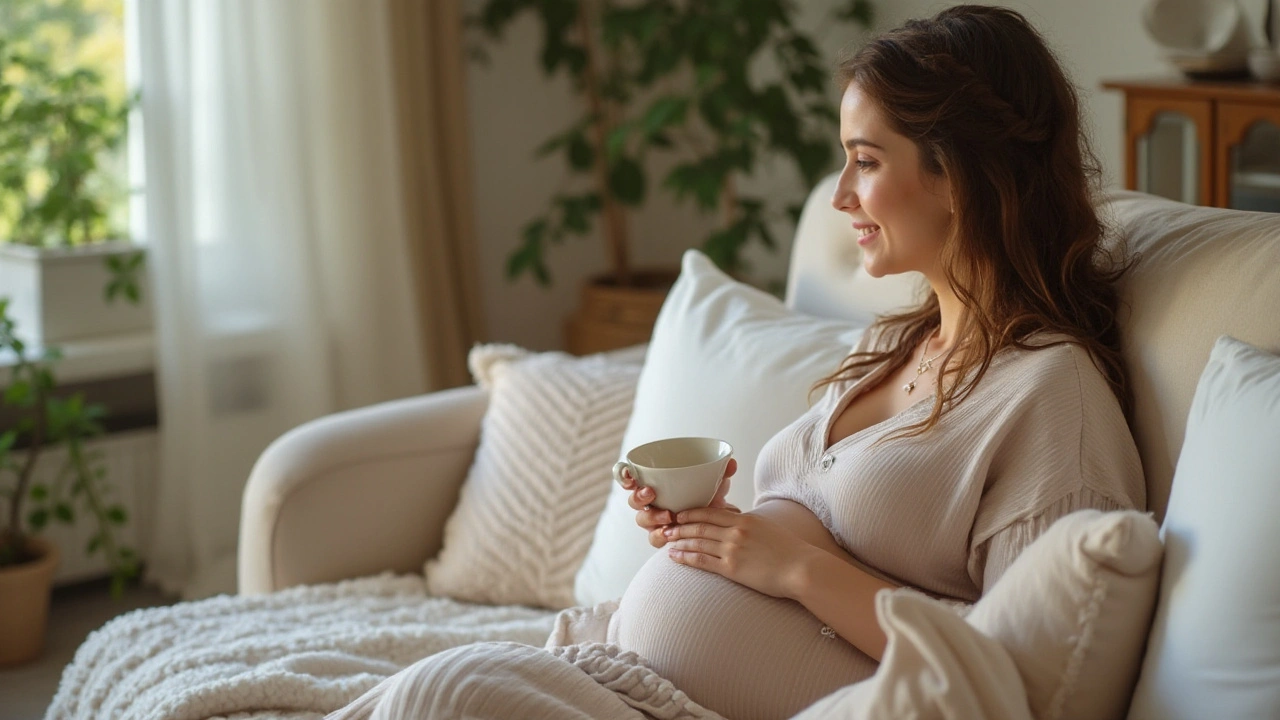


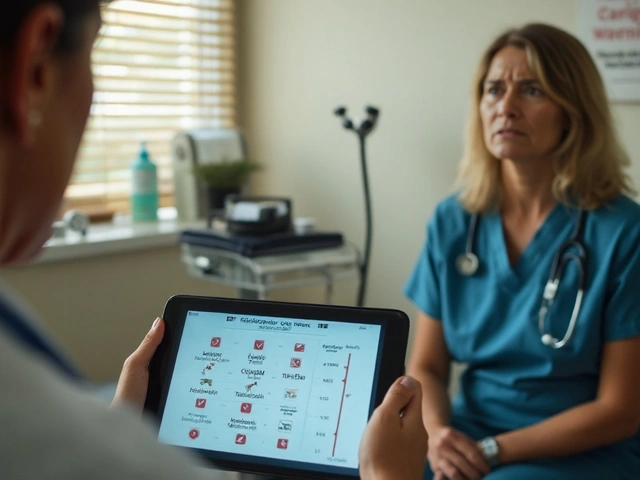
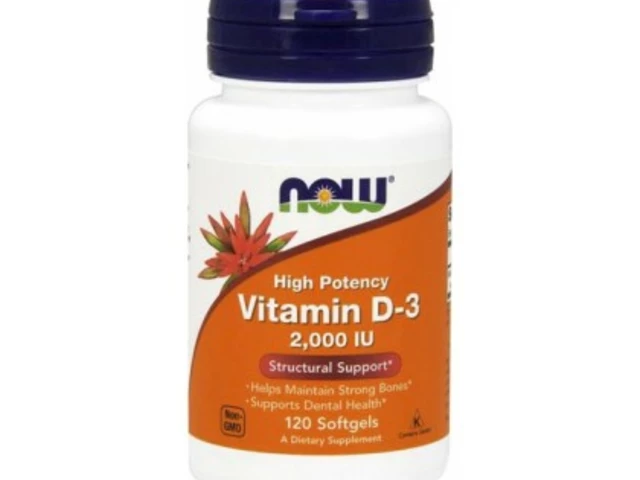

17 Comments
Ted Mann
Great tips, thanks!
Brennan Loveless
When we consider the way our bodies betray us in the first trimester, it becomes a philosophical exercise in surrender.
Morning sickness forces a reexamination of control, reminding us that the universe has its own agenda.
The choice of fabric, then, is not merely a fashion statement but a tactile negotiation with discomfort.
Cotton, bamboo, and modal become allies in a silent rebellion against the hormonal tide.
Loose silhouettes act as buffers, allowing the gut to settle without the oppressive pressure of tight waistbands.
Layering with breathable pieces respects the body's temperature fluctuations, a subtle nod to the thermoregulatory chaos of pregnancy.
Accessories like compression socks serve not only a circulatory function but a psychological one, grounding the bearer in a sense of stability.
One might argue that clothing is an extension of self-care, a visible commitment to nurturing the unborn.
Yet the real miracle is that a simple shift from synthetic polyester to natural fibers can mitigate nausea for many.
Vani Prasanth
I’ve found that breathable fabrics like linen and bamboo really help when my stomach feels queasy.
They keep me cool and the moisture‑wicking property stops me from feeling sticky after a bout of vomiting.
Also, elastic waistbands on maternity leggings let me adjust as my belly grows without feeling constricted.
Don’t forget to keep a water bottle handy – sipping small amounts can calm the nausea wave.
Overall, comfort is about the little details you choose each day.
Maggie Hewitt
Sure, because everyone loves a good fashion show when they’re about to hurl.
Mike Brindisi
Look, I’m not here to sugar‑coat the reality of morning sickness.
The hormones hit you like a freight train and the slightest pressure on your belly can make you feel like you’re about to lose your lunch.
That’s why I swear by loose‑fit tees and joggers that have a decent amount of stretch.
Silk may feel luxurious, but it’s a nightmare to wash and it slides right off when you’re trying to get dressed after a vomit episode.
Jersey knit tops are my go‑to because they move with you and you don’t have to wrestle with buttons.
And for anyone thinking a tight belt will give that “pregnancy glow,” think again – it just squeezes the stomach and makes the nausea worse.
Invest in a good maternity bra; proper support keeps you from slouching, which in turn eases pressure on your diaphragm.
Steven Waller
Supporting the physical aspect with mindful choices can also calm the mind.
When you feel supported by your clothing, the anxiety that fuels nausea naturally declines.
Choosing soft, breathable layers not only keeps you comfortable but signals to your brain that you’re safe.
That mental reassurance can be as powerful as any anti‑nausea remedy.
Puspendra Dubey
Secretly, I keep a peppermint oil dab on my wrist – works wonders.
Shaquel Jackson
Honestly, most of this feels like common sense, but the misery really hits when you’re lying on the couch, intolerant of every fabric.
Tom Bon
While one’s experience may differ, it is advisable to prioritize garments that do not constrict the abdomen, as this can exacerbate nausea.
Choosing attire that facilitates easy removal can also reduce the physical exertion required during an episode.
Clara Walker
Did you know that the government’s health agencies have been downplaying how synthetic fibers can worsen morning sickness?
It’s part of a larger scheme to push cheap, mass‑produced maternity wear that benefits big textile corporations.
Stay vigilant and read the tags – natural fibers are the only safe bet.
Jana Winter
Just a quick note: “downplaying” should be “downplaying,” and “synthetic fibers” is correct, but “mass‑produced” needs a hyphen. Also, “benefits” is plural, so the verb should be “benefit.”
Linda Lavender
Allow me to indulge in a brief exposition on the intricate relationship between textile selection and the physiological cascade known colloquially as morning sickness.
It is not merely a matter of aesthetic preference, but rather a sophisticated interplay between dermal receptors and the neurochemical signals emanating from an ever‑fluctuating hormonal milieu.
When the epidermis is cloaked in high‑grade cotton, the breathability facilitates evaporative cooling, thereby moderating the core temperature spikes that often precipitate nausea.
Conversely, artificial polymers such as polyester can insulate heat, creating a microenvironment of discomfort that aggravates the gastroduodenal sensitivity inherent to early pregnancy.
Moreover, the tactile feedback from loose‑cut garments serves as a gentle reminder to the somatic nervous system that there is no undue constriction, allowing the diaphragm to function unhindered.
Layering with soft, seamless fabrics not only provides thermal regulation but also offers a psychological sense of control, which has been demonstrated in several psychophysiological studies to mitigate stress‑induced nausea.
One cannot overlook the ancillary benefits of accessories; compression stockings, for instance, promote venous return, reducing the propensity for orthostatic hypotension that can further destabilize the stomach.
In summation, the deliberate curation of one’s wardrobe emerges as an underappreciated yet potent modality for ameliorating the tribulations of pregnancy‑related vomiting.
Jay Ram
That’s spot on – remember, every small adjustment is a step toward feeling better, so keep experimenting and you’ll find your comfort zone.
Sam Matache
Well, isn’t this just a delightful catalogue of fabric fantasies?
One would think we’re preparing for a runway, not a queasy morning.
Hardy D6000
Actually, it’s essential to recognize that not every pregnant person experiences nausea, so pushing these tips as universal seems a bit overblown.
Amelia Liani
I completely understand how overwhelming it can feel; I’ve been there, and finding the right combo of soft fabrics and supportive accessories made a huge difference for me.
Take it one step at a time, and don’t hesitate to ask your doctor for personalized advice.
kevin muhekyi
Exactly, your well‑being matters, and a comfortable wardrobe is a simple yet powerful way to take care of yourself during this journey.